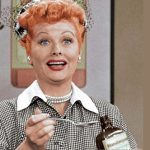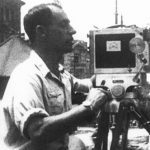 Mysteries
Mysteries  Mysteries
Mysteries  History
History 10 Surprising Stories About the Texas Rangers
 Humans
Humans 10 Philosophers Who Were Driven Mad by Their Own Theories
 Miscellaneous
Miscellaneous 10 Video-Game-Worthy Weapons and Armors from History
 Weird Stuff
Weird Stuff 10 Psychics Who Accurately Predicted Wartime Events
 The Arts
The Arts 10 Pieces of Art Inspired by a Broken Heart
 Health
Health 10 Science Fiction-Sounding New Medical Treatments
 History
History 10 Surprising Facts About the Father of Submarine Warfare
 Space
Space Ten Astonishing New Insights into Alien Worlds
 Weird Stuff
Weird Stuff 10 Bizarre Summer Solstice Rituals Still Practiced Today
 Mysteries
Mysteries Top 10 Haunting Facts About the Ghost Ship MV Alta
 History
History 10 Surprising Stories About the Texas Rangers
 Humans
Humans 10 Philosophers Who Were Driven Mad by Their Own Theories
Who's Behind Listverse?

Jamie Frater
Head Editor
Jamie founded Listverse due to an insatiable desire to share fascinating, obscure, and bizarre facts. He has been a guest speaker on numerous national radio and television stations and is a five time published author.
More About Us Miscellaneous
Miscellaneous 10 Video-Game-Worthy Weapons and Armors from History
 Weird Stuff
Weird Stuff 10 Psychics Who Accurately Predicted Wartime Events
 The Arts
The Arts 10 Pieces of Art Inspired by a Broken Heart
 Health
Health 10 Science Fiction-Sounding New Medical Treatments
 History
History 10 Surprising Facts About the Father of Submarine Warfare
 Space
Space Ten Astonishing New Insights into Alien Worlds
 Weird Stuff
Weird Stuff 10 Bizarre Summer Solstice Rituals Still Practiced Today
Top 10 TV Theme Songs of the 1970s
In the early 1970s, cable networks had yet to arrive. The Big Three—ABC, CBS, and NBC continued to dominate American television, routinely airing shows seen in aggregate by 90% of viewers. Producers knew their shows needed huge numbers of viewers to survive intense competition from the other networks, so they played it safe in their programming strategies.
But social change was forcing cracks in entertainment conformity. For instance, in 1971, CBS canceled its traditional small-town and rural shows in favor of urban shows addressing controversial topics. Shows such as Good Times, Sanford and Son, and Chico and the Man featured ethnic characters rarely seen before on TV. Actresses were given leading roles without a husband or even a boyfriend. One Day at a Time featured a divorced mother raising teenage daughters. Maude, played by Bea Arthur, was an outspoken woman with a mild-mannered husband.
These changes also affected theme songs. Veteran songwriter Charles Fox described his goal for a theme song, “You always want to capture what you think is the essence of the show, and you want to make something that’s bright and interesting and attractive. If he could write a song that would make the viewer take notice and watch the show, he succeeded. It was crucial for TV to have evocative music and socially conscious lyrics associated with their shows. If the song was an instrumental, it had to be instantly recognizable. The following theme songs all fulfilled these goals and then some.
Related: Top 10 TV Shows Cancelled Too Soon
9 Happy Days: 1974–1984
Happy Days focused on life among teenagers in 1955 Milwaukee. The star was a fresh-faced high school boy, Richie Cunningham, played by Ron Howard, who earlier had played Opie on The Andy Griffith Show. Stories about Richie’s friends Potsie, Ralph Malph, and Fonzie and Richie’s family were also featured. Fonzie, played by Henry Winkler, stole the show with his cool leather jacket and tough guy act, thinly disguising his heart of gold. The show spun off several shows, including huge hits like Mork & Mindy and Laverne & Shirley.
During the first two seasons, producer Garry Marshall used Bill Haley and the Comets’ real-life 1950s hit song “Rock Around the Clock” as the opening theme song. “Happy Days” was used at the end of each show. In 1976, “Happy Days” opened the show and remained the theme song for the rest of the run of the show. A jukebox loaded a record, a genuine 45 rpm with “Happy Days” printed on the label, and the song began. Its bouncing rhythm and catchy lyrics promised viewers a fun half-hour of nostalgia. The song became a hit, reaching number 25 on the Billboard charts. It was written by veteran TV theme writers Norman Gimbel and Charles Fox.[1]
9 The Waltons: 1972–1981
The Waltons can be considered counterprogramming in light of social changes in the 1970s. It was rural and nostalgic. Yet it became hugely popular, earning two Golden Globes and one Emmy. It commemorates the early life of creator Earl Hamner Jr., based on his novel Spencer’s Mountain and a movie of the same name.
In 1971, CBS aired a made-for-TV movie, The Homecoming, which turned out to be the pilot for the TV series. The Waltons is the story of a large, close-knit family living on Walton’s Mountain in Great Depression-era West Virginia. John-Boy Walton, an aspiring writer, is the oldest of seven children. Parents and grandparents impart traditional values to the children in response to family trials. That charming closing scene to each episode featuring numerous “good nights” being said by the children grew out of Hamner’s own childhood memories.
Long-time TV theme song composers Gerry Goldsmith and Alexander Courage wrote the haunting, unforgettable Waltons instrumental. The Daniel Caine Orchestra performed it, but Chuck Mangione’s flugelhorn lent poignancy to the lovely melody. He later achieved superstardom with his hit song “Feels So Good.”[2]
8 The Muppet Show: 1976–1981
The Muppets, made famous by their daily appearances on PBS’s Sesame Street, were brought out into prime time by Jim Henson and Frank Oz. They wanted to create a show both children and adults could enjoy. Each week, Kermit the Frog would host a half-hour variety show in the Muppet Theatre featuring his fellow Muppets and one guest celebrity. The show would serve as a time capsule for 1970s musical and acting talent.
Fozzy Bear, Miss Piggy, Animal, and the Swedish Chef were highlighted. Things always went awry as the Muppets tried to make sure the show would go on. Up in the balcony perched two old codger Muppets, Statler and Waldorf, famously heckling the proceedings. The show was videotaped at ATV and distributed by Great Britain’s ITC Entertainment around the world.
Jim Henson’s and Sam Pottle’s lyrics were pure show biz: “It’s time to put on makeup/It’s time to dress up right/It’s time to raise the curtain/On the Muppet Show tonight!” The song began as a fancy variety show title card is shown. The camera zoomed into the letter O which would open and reveal Kermit as the emcee of the show.[3]
7 M*A*S*H: 1972–1983
M*A*S*H was an American television series about a team of medical personnel stationed at the 4077th MASH—Mobile Army Surgical Hospital—during the Korean War. The show, like the movie of the same name directed by Robert Altman, was based on Richard Hooker’s autobiographical novel. It was hugely popular during its long run, garnering 14 Emmys.
The show depicted the efforts by surgeons Hawkeye Pierce and Trapper John McIntire to save as many lives as possible by conducting “meatball surgery” while keeping reasonably sane. Major Hot Lips Houlihan and Major Frank Burns kept things hopping as the surgeons’ nemeses. Radar O’Reilly alerted the camp about incoming wounded before anyone else knew what was going on. Fans noted with amusement that the show lasted three times longer than the war.
This beautiful melody was written by Johnny Mandel for the film’s most infamous scene, referred to as the “last supper.” It depicted a fake suicide. Robert Altman’s teenage son was asked to write deliberately stupid lyrics for the scene. Altman wanted the scene to be ridiculous. But his son came up with some truly poignant observations on the reality of suicide. However, these words were far too explicit for the TV show. Producer Larry Gelbart chose an instrumental version performed by The Hollywood Prime Time Orchestra. Michael Altman received over a million dollars in royalties over the years as a co-writer of that song.[4]
6 The Jeffersons: 1975–1985
Cultural critics, including the Black Panthers, blasted TV executives for portraying black people as poverty-stricken victims. Producer Norman Lear took the charge seriously. While All in the Family was rising in the ratings, he decided the Bunkers should have a black family as neighbors. And so, the Jeffersons came to be.
The father, George Jefferson, owned and operated an increasingly successful chain of dry cleaners. At that point, the Jeffersons were ready to move on up to Manhattan’s east side. The Jeffersons became All in the Family’s first spinoff show. This new show made cultural waves not only by depicting a wealthy black family but also by marrying son Lionel into a mixed-race family. Superb comedic writing lightened any cultural shock viewers might have experienced.
The Jefferson’s theme song is far more memorable than the show itself. The song was co-written by Ja’net DuBois and Jeff Barry, who gave it a strong Gospel feeling. DuBois belted out the “We’re moving on up” lyrics herself with the backing of a 35-member gospel choir, a piano, and a lot of hand-clapping. When DuBois got to the line “Now we up in the big leagues,” Oren Waters joined in, creating a wonderful duet, evoking the joy George and “Weezie” felt as they finally got a piece of the pie.[5]
5 Welcome Back, Kotter: 1975–1979
The title itself reveals the show’s premise. Gabriel Kotter, played by Gabe Kaplan (also the show’s co-creator), is a compassionate teacher who returns to his old alma mater, inner-city Buchanan High School. There he teaches kids who are very much like he was when he was young. The Sweathogs are all underachievers serving time in a remedial class. Under Kotter’s tutelage, however, they begin learning things.
The most noteworthy of the Sweathogs was played by future movie superstar John Travolta. Vinnie Barbarino came up with all kinds of amusing insults, including “Up your nose with a rubber hose!” The show tackled edgy issues such as violence, teenage pregnancy, and drug abuse without ever losing its comedic touch.
The Lovin’ Spoonful’s founder, John Sebastian, wrote and performed the song. It was supposed to be titled “Welcome Back, Kotter,” but Sebastian couldn’t find the right words to rhyme with Kotter, so he turned the song into a nostalgic story about an unnamed man returning home. It worked. The song hit number 1 on the Billboard charts in 1976. The show was originally going to be called Kotter. The theme song would be “Welcome Back.” The producers made a sensible decision by blending the titles.[6]
4 The Rockford Files: 1974–1980
The Rockford Files was James Garner’s first TV series as a solo lead. Show creator Roy Huggins turned Garner’s old character, Bret Maverick, into a modern-day private eye. The ploy worked. The Rockford Files became one of the most popular shows in history. James Garner played Jim Rockford as a Los Angeles private detective who was not doing well financially. He operated out of his mobile home. Rockford attempted to avoid violence by engaging witnesses and suspects in friendly conversations. Rockford’s Pontiac Firebird played a key role in the chase scenes.
Each episode began with the sound of a beep. An answering machine message sounded, usually a complaint from a creditor. When the message ended, the theme song began. This energetic instrumental featured a Minimoog synthesizer, flutes, French horns, trombones, and a blues harmonica. A bridge was played by Dan Ferguson with an electric guitar. Mike Post and Pete Carpenter wrote the song. It made it into the top 10 on Billboard in 1975 and won a Grammy. This was the first song with a Minimoog that became a hit.[7]
3 Dallas: 1978–1991
Dallas was the first of TV’s sprawling prime-time soap operas. Producer David Jacobs created it originally as a miniseries in April 1978. It continued as a weekly show for 13 seasons, becoming so popular that producers created several other shows in this genre, including Knot’s Landing and Dynasty.
Dallas followed the efforts of tycoon J.R. Ewing to protect the Ewing oil business from competitors, including the Barnes family. Other family members were featured in the show’s convoluted storylines, including brother Bobby and parents Jock and Miss Ellie Ewing. A defining moment in the show was the “Who Shot J.R.?” cliffhanger. The episode that resolved the mystery became the single most-watched show in American television history. Dallas eventually aired in over 130 countries and received 4 Emmys.
This instrumental was composed by Jerrold Immel, a veteran TV composer. It contains elements of cowboy music played by an orchestra and a synthesizer. It evoked elements of the Texas mythos, large ranches, oil wealth, and political power, themes echoed by the accompanying visuals of skyscrapers, fancy cars, cowboys herding cattle, and the Southfork ranch house. The song reminds the viewer of Aaron Copeland’s music.[8]
2 All in the Family: 1971–1979
Norman Lear and Bud Yorkin created and produced this breakthrough show based on Till Death Do Us Part, a British series. This American version was set in Queens, New York. It featured outspoken dockworker Archie Bunker, played to the hilt by Carroll O’Connor. The Bunker household consisted of Archie, his wife Edith, his daughter Gloria, and her husband, Mike.
Sparks flew as Archie and Mike battled over politics. Brilliant writing and even more brilliant acting created a show that was so funny the politics didn’t hurt at all. All in the Family may be the most influential TV show in history. But at its height in popularity, at least half the audience in that time slot was watching.
“Those Were the Days” was written by Charles Strouse and Lee Adams. The show opened with an overview shot of Manhattan, then moved in closer and closer in Queens to 704 Hauser Street. There they were, Archie and Edith, in the living room, reminiscing about their experiences in the early 1940s. Carroll O’Connor and Jean Stapleton as the Bunkers were sitting at a piano singing “Boy, the way Glenn Miller played. Songs that made the Hit Parade…” Originally a cost-cutting measure, this piano introduction turned out to be one of the most brilliant maneuvers in TV theme song history.[9]
1 The Mary Tyler Moore Show: 1970–1977
Mary Richards was a single woman in her thirties in Minneapolis. She had just been hired by Lou Grant as a television producer at WJM. This historic occasion marked the first time a female lead was unmarried and living alone in an American television series. Instead of making explicitly political points with this story, Grant Tinker—husband of Mary Tyler Moore and co-creator with her of the MTM production company—approached these issues subtly.
Mary simply interacted as an equal with Lou, Murray, and Ted. She laughed and cried with Rhoda and Phyllis in that iconic Victorian house. It all became so natural, so fitting. The show was superbly written and acted, enough so that it won an astounding 29 Emmys during its seven-year run.
“Who can turn the world on with her smile?
Who can take a nothing day
And suddenly make it all seem worthwhile?”
“Love Is All Around” is impossible to hear without humming along. The story of its creation is worth a one-act play. Veteran composer Sonny Curtis remembered being asked by a friend to compose a theme song for the show. With barely a paragraph description of the show in hand, he wrote the song. He arrived at an empty CBS soundstage for an audition and was greeted by a crabby executive. One performance of the song erased the man’s bad mood. By the time he played it the tenth time, the room was full of enthusiastic people. Sold!
At the beginning of each episode, the song was accompanied by a montage of Twin Cities images—Mary walking by Lake of the Isles, Mary window shopping on Nicollet Mall, Mary riding an escalator, Mary dining at a table on the second-floor balcony at the IDS Crystal Court, and most memorably, Mary tossing her hat high in the air. Years later, Mary remembered the director telling her, “Go. Do it.” And she did. A statue in front of the old Dayton’s Department Store in downtown Minneapolis commemorates the iconic scene.[10]








